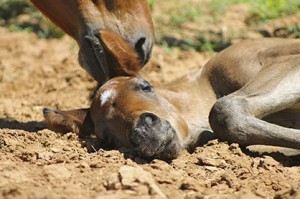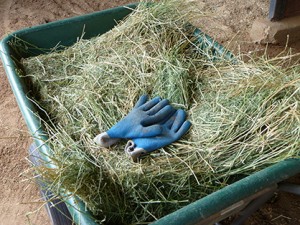Botulism: May Be Good For Wrinkles, But It’s Deadly For Horses
By: Heather Smith-Thomas
Botulism is a highly fatal disease caused by toxins produced by spore-forming bacteria (several types of Clostridium botulinum) found in the environment, generally in the soil. These bacteria often live harmlessly in the digestive tracts of plant-eating animals such as horses and cattle but generally do not cause disease except under certain conditions in which they multiply and create toxins. Botulism causes “shaker foal syndrome” in which affected foals become weak and collapse.
Dr. Kim Sprayberry, Associate Professor, Animal Science Department, Cal Poly University, San Luis Obispo, California says it is the toxin produced by these bacteria that is deadly. “Clostridium botulinum produces an exotoxin when conditions are right,” she says. One of the major factors is lack of oxygen in body tissues, since these bacteria love an anaerobic environment.”
“In foals, for example, it is thought that they get it because a high percentage of foals have ulcers or erosions in the GI tract lining where the oxygen level is lower in those tissues. The clostridium can germinate in there and create the toxin. Nearly every foal has some erosions (which can be detected if you scope them), and this is what makes them susceptible to botulism,” she says.
There are several types of these bacteria. Type A, B and C are probably the most common ones that can infect horses. “Here on the West Coast, we typically see Type C. In the Mid-Atlantic states and Kentucky, we see Type B predominantly,” she says.
“Type B, which is often seen in foals, is also called toxico-infectious botulism. This means there is actually a Clostridium botulinum infection in the tissues and it starts to make the toxin. Type C creates what is called forage poisoning. The horses are eating toxins that are already present in the feed. The third form of botulism is called wound botulism. This can occur with a puncture wound or some other wound with low oxygen levels,” says Sprayberry.
There are some antitoxin products for treating horses with botulism, but since the disease can kill a horse quickly, it’s best to try to prevent it. Unfortunately, there is no vaccine that covers all types. “The vaccine available protects horses only against Type B. Thus much of our prevention efforts must be in how we manage the horses rather than relying on a vaccine,” Sprayberry says.
For horses in the eastern part of the country, where Type B is common, owners try to prevent shaker foal syndrome by vaccinating the dams before the foals are born. “This works best if mares are vaccinated in a series of three injections prior to parturition so the mare will have antibodies in her colostrum, to give the foal protection,” she says.
There is no Type A or C vaccine commercially available for horses. “Thus the best strategy is to try to prevent exposure. Some of the largest outbreaks have been linked to processed feeds in which alfalfa or other forages have been cubed or processed and extruded into pellets,” says Sprayberry.
When hay is cut and baled, sometimes small animals get caught and killed by the haying equipment. “The carcasses that decompose inside the bales, or parts of a carcass inside a pellet, may harbor spores that amplify and germinate in the low-oxygen environment. A horse that is fed a flake of hay with part of a dead animal in it will smell it and avoid eating the hay around it. There is still some danger if toxin leached out into the surrounding hay, but not as much risk as with a cube or pellet because generally the horse can’t detect the contamination and will eat it—not being able to detect a difference,” she explains.
“One way to avoid this risk is to not feed cubes or pellets. You can also check the hay you are feeding, making sure there is nothing foreign inside the bale.” This is harder to do with big bales. Feeding big bales is always risky because even though they might look good on the outside, you don’t know what’s inside. There may be areas of spoilage that have created perfect conditions for proliferation of these bacteria.













